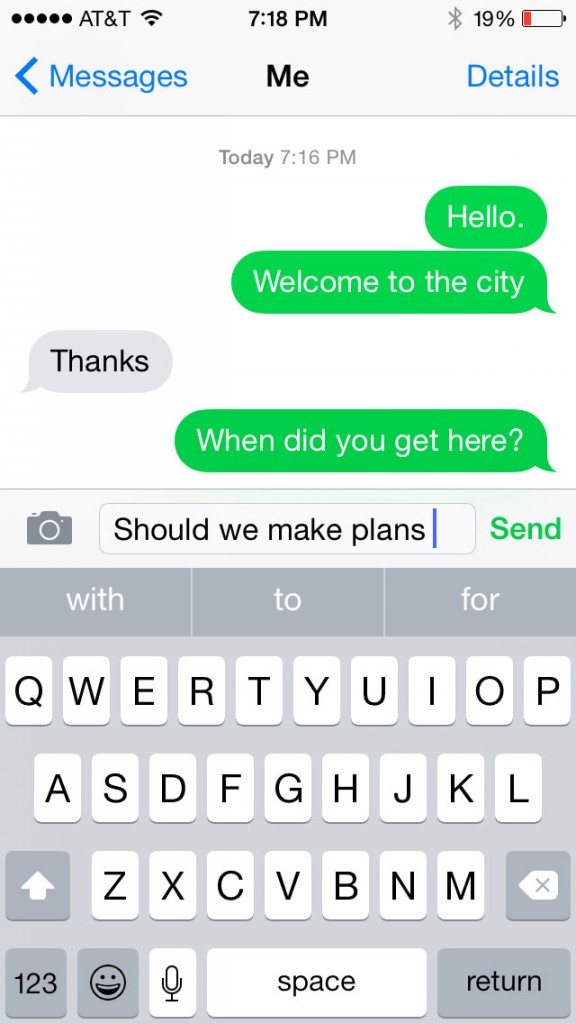
With iOS 8, Apple wants to drastically change your relationship with your phone. Unlike the aesthetically dynamic changes introduced in iOS 7, iOS 8 doesn’t refresh the way your phone looks, but it does change the way your phone behaves, in a way that makes the iPhone more like everything else on the smartphone market.
Upon downloading iOS 8, some things seem a little different, but it takes some use to realize everything that’s changed. If you’re using an older phone like the 4s, be prepared for some lag, although most of the kinks seemed to sort themselves out a few days into the update. The new operating system was designed for larger architectures, like the 5 and the 6 series of iPhone. While the 4s is a beautifully designed phone and still one of the most reliable on the market, this is likely the last big iOS update for which it will be eligible.
The update offers some great new features that improve the iPhone experience. First is the new customization of message threads. From the new “Details” page, group chats can now be named, and individual message threads can now be set to “do not disturb,” which allows you to control which messages you get notifications for. The page also has a feed of all the pictures and videos that were sent between both parties. Messages can now be replied to while within third party apps from the notification banner.
Third party developers will now be able to use the Touch ID (applicable to the iPhone 5s, iPhone 6 and iPhone 6 Plus), allowing added security in some of the more vulnerable apps like SnapChat and Twitter. Once applied, the option to lock individual apps will prevent people from posting/sending content from your phone without your permission.
Apple has also updated its Spotlight search, which was almost pointless until now. Instead of just searching locally on your iPhone, Spotlight expands its search into the web in order to find more complete suggestions to your queries. For example, when searching “movies,” Spotlight will pull a list of movies playing in theaters near you.
Lastly, a new feature has been added to safeguard photos against accidental deletions. Now when you delete photos, they’re stored in a folder called “Recently Deleted,” where you can retrieve them until a set number of days has passed. To permanently delete a photo, you either have to go into the “Recently Deleted” folder to completely delete it or wait out the clock. While this is inconvenient when trying to clear space on your phone, it’s a nice safety net to have.
Other features just aren’t that important or weren’t executed well. The new predictive keyboard was Apple’s attempt to deliver a “smarter keyboard,” but it’s an Android knockoff with a crowded mess of numbers and letters. While predictive text offers contextually appropriate suggestions that learns from your daily language, it’s really only useful for people who need their phone to tell them what they want to say. Thankfully, you can turn this feature off in the settings. Also, the addition of the audio messaging seems a bit excessive; it’ll either catch on or it won’t.
Another annoyance is yet another app slot being occupied with another pointless Apple app. It’s called “Tips,” and although the logo is well designed, the app is the most worthless application Apple has ever produced. “Tips” functions to provide you with tips on how to use your iPhone. Unless you’re 85 and partially blind, you’ve probably already figured out how to use an iPhone. It’s not complicated enough to warrant a dedicated how-to app.
The other new feature is the Health app, which lets the user upload data about their daily routine. Most notably, the app allows you to create a Medical ID which includes important allergies and medical conditions that can be accessed from your phone’s emergency dialer without unlocking your phone. While the app probably works best with the new Apple Watch, the everyday user will probably just ignore the app unless they care to take advantage of the Medical ID.
Like any substantial upgrade, time needs to pass before the usefulness of the all the new iOS 8 features can be properly realized. While the design aesthetic hasn’t changed, the update is a sign that Apple is moving in a much more conventional direction with its new iPhone 6 and iOS 8.


